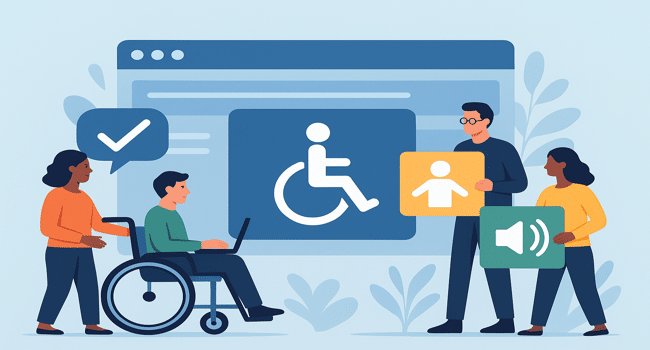Table of Contents
The internet was never meant to exclude All people. Yet in 2025, countless websites still fail to meet accessibility requirements — locking out thousands and thousands of customers with disabilities. That’s now not simply horrific UX; it’s bad enterprise.
Accessibility isn’t an add-on or a compliance checkbox — it’s a mindset. It’s about designing digital experiences that empower all people to have interaction equally, no matter potential, age, or tool. As a leading provider of custom website development services in the USA, Inclusive design should be at the heart of every digital product, ensuring that technology serves everyone equally. After all, a web built for everyone isn’t a feature — it’s the future.
Why Web Accessibility Matters More Than Ever
The global shift in the direction of virtual-first business means that your internet site is your logo. And while your website isn’t reachable, you’re sending an unstated message: a few customers don’t depend.
More than one thousand million individuals, states the World Health Organization, stay with some form of incapacity. That is a huge following that most brands unwittingly overlook. Accessibility is what makes it possible for your message, services, and products to be heard by everyone — including users who use assistive technologies such as screen readers or voice commands.
And the benefits go beyond inclusivity:
- Better SEO: Search engines reward reachable web sites with advanced ratings.
- Stronger Brand Reputation: Inclusive design indicators empathy and management.
- Wider Audience Reach: More customers can have interaction with your content and products.
- Reduced Legal Risk: Meeting WCAG and ADA compliance continues you beforehand of guidelines.
From Compliance to Compassion: Building Accessible Experiences
Accessibility starts offevolved with goal. It’s now not pretty much alt textual content or evaluation ratios — it’s approximately empathy-driven design.
Here’s how cutting-edge businesses can lead the change:
- Adopt Accessible Frameworks: Build with semantic HTML, ARIA labels, and display-reader-pleasant navigation.
- Design for All Devices: Optimize for computer, mobile, and assistive technologies.
- Prioritize Clarity: Clear content, sturdy evaluation, and easy UI assist each person.
- Test with Real Users: Accessibility isn’t theoretical. It’s human. Conduct usability testing with diverse groups.
The Business Case for Inclusion
Creating on hand websites isn’t just the right component to do; it is also excellent for business. Companies that keep in mind accessibility regularly report higher user delight, more potent engagement, and extra client loyalty. A web development company that Virtual spaces which are designed with accessibility in thoughts allow purchasers to spend extra time on the internet site, convert greater quickly, navigate with ease, and emerge as ardent supporters of the brand.
Accessibility and innovation are closely associated. Platforms which can be person-pleasant, brief, and inclusive outperform competitors which are firmly rooted in antiquated layout techniques. Accessibility is therefore a benefit as opposed to a drawback.
The Future Is Inclusive
With technological improvements, our know-how of desirable design have to exchange too. The subsequent era of the web might be predicated on equitable inclusion, from voice interfaces and AI personalization to built-in design questioning standards that ensure each person feels represented and cared for.
The manufacturers that win the next day could be those developing for all these days.
FAQs — Building a Web for Everyone
1. What is web accessibility, and why is it important?
Web accessibility guarantees that web sites, apps, and digital structures are usable through each person — which includes humans with disabilities. It’s crucial as it creates identical access, improves user enjoy, boosts search engine marketing, and strengthens logo consider.
2. How can businesses make their websites more accessible?
Companies can start with the aid of adhering to WCAG (Web fabric Accessibility Guidelines), which consist of utilising suitable color comparison, structuring cloth with meaningful HTML, providing entire keyboard browsing, and presenting alt textual content for snap shots. Frequent accessibility trying out additionally makes it feasible to spot usability problems early.
3. Does accessibility improve SEO performance?
Yes. While web sites which might be accessible are well-dependent, consumer-pleasant, and full of treasured material, search engines like Google desire them. Your website is more searchable and visible in seek consequences when it has capabilities like alt textual content, captions, and clean code.
4. How do companies build accessible digital experiences?
Companies Integrate accessibility into every level of web and mobile app development — from UX design to code implementation. Our awareness is on growing seamless, inclusive, and compliant virtual experiences that empower every user and improve business performance.
Read more on KulFiy
